load capacity TOYOTA PRIUS PLUG-IN 2013 Owners Manual
[x] Cancel search | Manufacturer: TOYOTA, Model Year: 2013, Model line: PRIUS PLUG-IN, Model: TOYOTA PRIUS PLUG-IN 2013Pages: 704, PDF Size: 19.59 MB
Page 358 of 704

332
2-4. Using other driving systems
PRIUS PHV_OM_OM47787U_(U)
CAUTION
■Replacing tires
Make sure that all tires are of the specified size and of the same brand, tread
pattern and total load capacity. In addition, make sure that the tires are
inflated to the recommended tire inflation pressure level.
The ABS and VSC systems will not function correctly if different tires are
installed on the vehicle.
Contact your Toyota dealer for further information when replacing tires or
wheels.
■Handling of tires and the suspension
Using tires with any kind of problem or modifying the suspension will affect
the driving assist systems, and may cause a system to malfunction.
Page 369 of 704
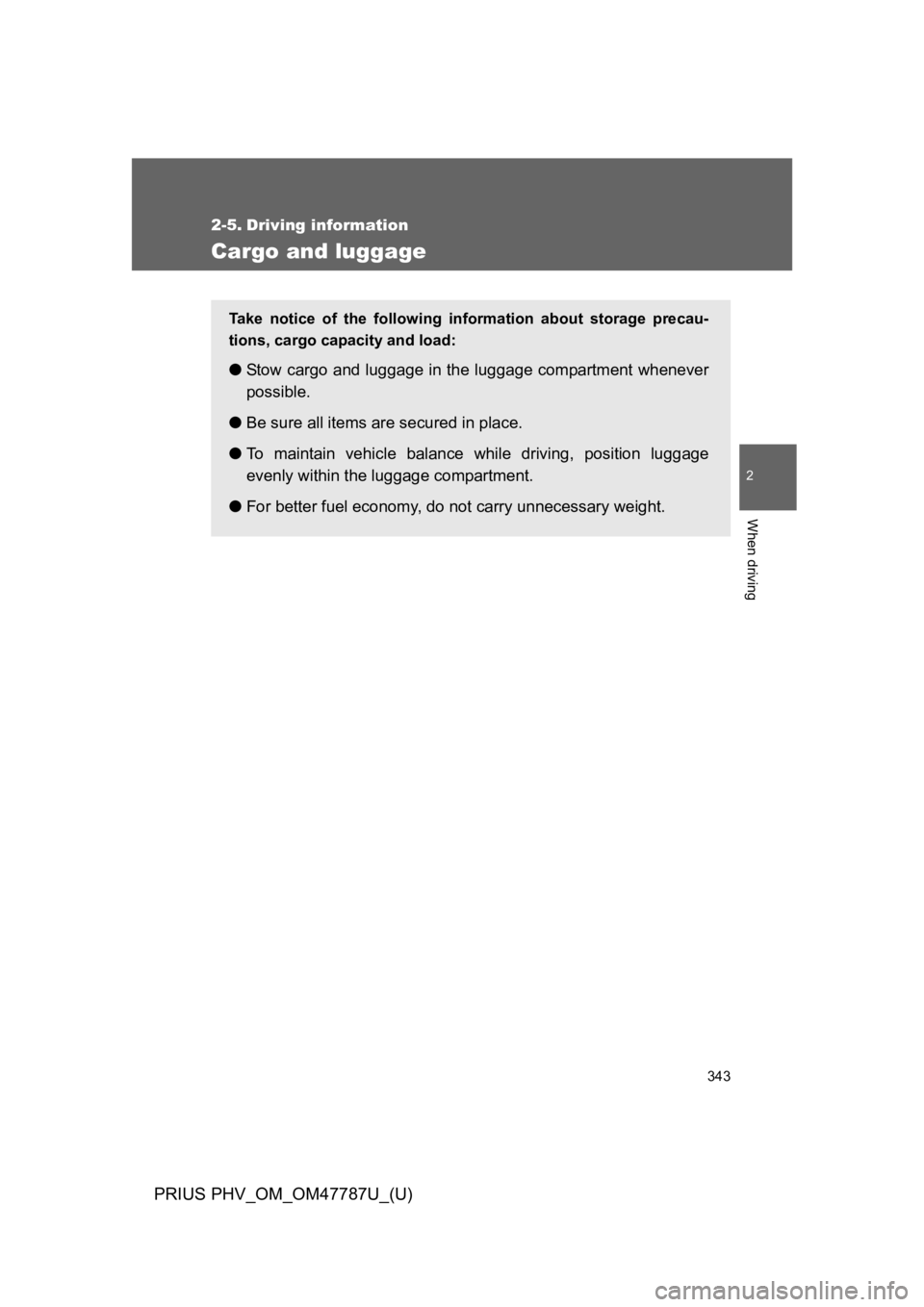
343
PRIUS PHV_OM_OM47787U_(U)
2
When driving
2-5. Driving information
Cargo and luggage
Ta k e n o t i c e o f t h e f o l l o w i n g i n f o r m a t i o n a b o u t s t o r a g e p r e c a u -
tions, cargo capacity and load:
●St ow carg o a nd lug gag e in the lu gga ge compartment wh enever
possible.
●Be sure all items are secured in place.
●To m a i n t a i n v e h i c l e b a l a n c e w h i l e d r i v i n g , p o s i t i o n l u g g a g e
evenly within the luggage compartment.
●For better fuel economy, do not carry unnecessary weight.
Page 370 of 704

344
2-5. Driving information
PRIUS PHV_OM_OM47787U_(U)
Capacity and distribution
Cargo capacity depends on the total weight of the occupants.
(Cargo capacity) = (Total load capacity) — (Total weight of occupants)
Steps for Determining Correct Load Limit ⎯
(1) Locate the statement “The combined weight of occupants and
cargo should never exceed XXX kg or XXX lbs.” on your vehicle’s
placard.
(2) Determine the combined weight of the driver and passengers that
will be riding in your vehicle.
(3) Subtract the combined weight of the driver and passengers from
XXX kg or XXX lbs.
(4) The resulting figure equals the available amount of cargo and lug-
gage load capacity.
For example, if the “XXX” amount equals 1400 lbs. and there will
be five 150 lb passengers in your vehicle, the amount of available
cargo and luggage load capacity is 650 lbs. (1400 − 750 (5 × 150)
= 650 lbs.)
(5) Determine the combined weight of luggage and cargo being
loaded on the vehicle. That weight may not safely exceed the
available cargo and luggage load capacity calculated in Step 4.
(6) If your vehicle will be towing a trailer, load from your trailer will be
transferred to your vehicle. Consult this manual to determine how
this reduces the available cargo and luggage load capacity of
your vehicle. (→P. 3 4 8 )
To y o t a d o e s n o t r e c o m m e n d t o w i n g a t r a i l e r w i t h y o u r v e h i c l e . Yo u r
vehicle is not designed for trailer towing.
Page 371 of 704
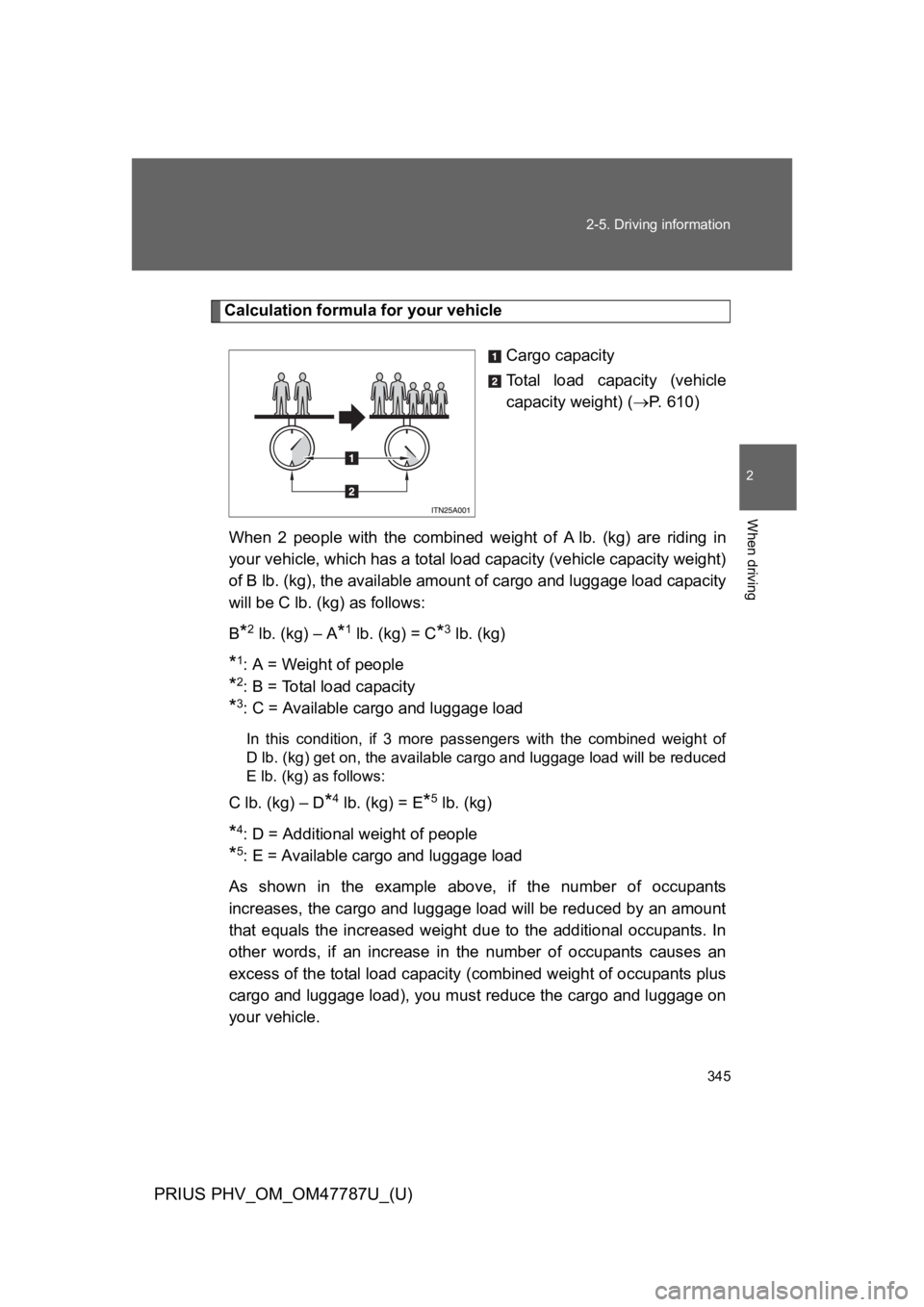
345
2-5. Driving information
PRIUS PHV_OM_OM47787U_(U)
2
When driving
Calculation formula for your vehicle
Cargo capacity
To t a l l o a d c a p a c i t y ( v e h i c l e
capacity weight) (→P. 6 1 0 )
When 2 people with the combined weight of A lb. (kg) are riding in
your vehicle, which has a total load capacity (vehicle capacity weight)
of B lb. (kg), the available amount of cargo and luggage load capacity
will be C lb. (kg) as follows:
B*2 lb. (kg) – A*1 lb. (kg) = C*3 lb. (kg)
*1: A = Weight of people
*2: B = Total load capacity
*3: C = Available cargo and luggage load
In this condition, if 3 more passengers with the combined weight of
Dlb. (kg) get on, the available cargo and luggage load will be reduced
E lb. (kg) as follows:
C lb. (kg) – D*4 lb. (kg) = E*5 lb. (kg)
*4: D = Additional weight of people
*5: E = Available cargo and luggage load
As shown in the example above, if the number of occupants
increases, the cargo and luggage load will be reduced by an amount
that equals the increased weight due to the additional occupants. In
other words, if an increase in the number of occupants causes an
excess of the total load capacity (combined weight of occupants plus
cargo and luggage load), you must reduce the cargo and luggage on
your vehicle.
Page 373 of 704
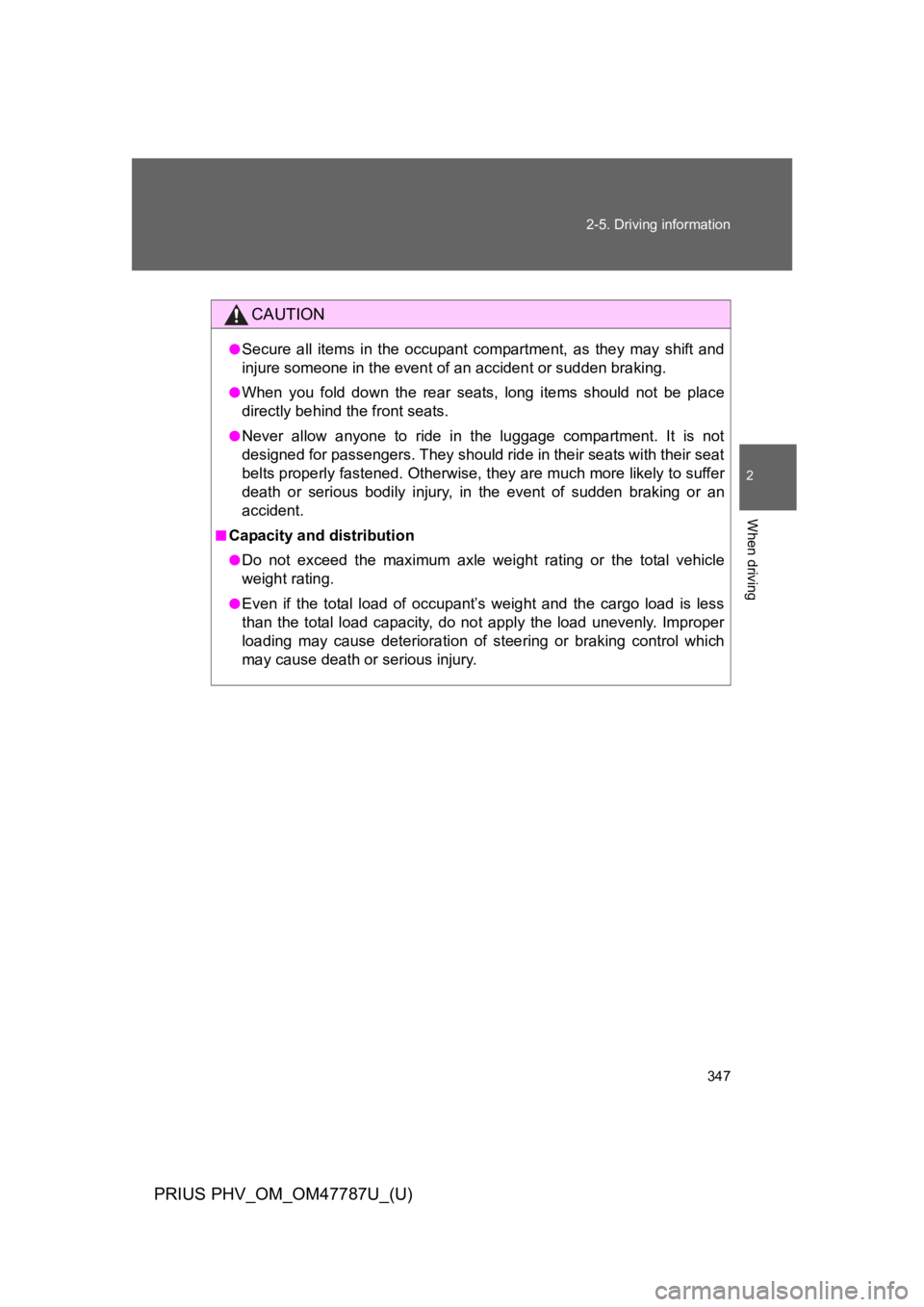
347
2-5. Driving information
PRIUS PHV_OM_OM47787U_(U)
2
When driving
CAUTION
●Secure all items in the occupant compartment, as they may shift and
injure someone in the event of an accident or sudden braking.
●When you fold down the rear seats, long items should not be place
directly behind the front seats.
●Never allow anyone to ride in the luggage compartment. It is not
designed for passengers. They should ride in their seats with their seat
belts properly fastened. Otherwise, they are much more likely to suffer
death or serious bodily injury, in the event of sudden braking or an
accident.
■Capacity and distribution
●Do not exceed the maximum axle weight rating or the total vehicle
weight rating.
●Even if the total load of occupant’s weight and the cargo load is less
than the total load capacity, do not apply the load unevenly. Improper
loading may cause deterioration of steering or braking control which
may cause death or serious injury.
Page 374 of 704
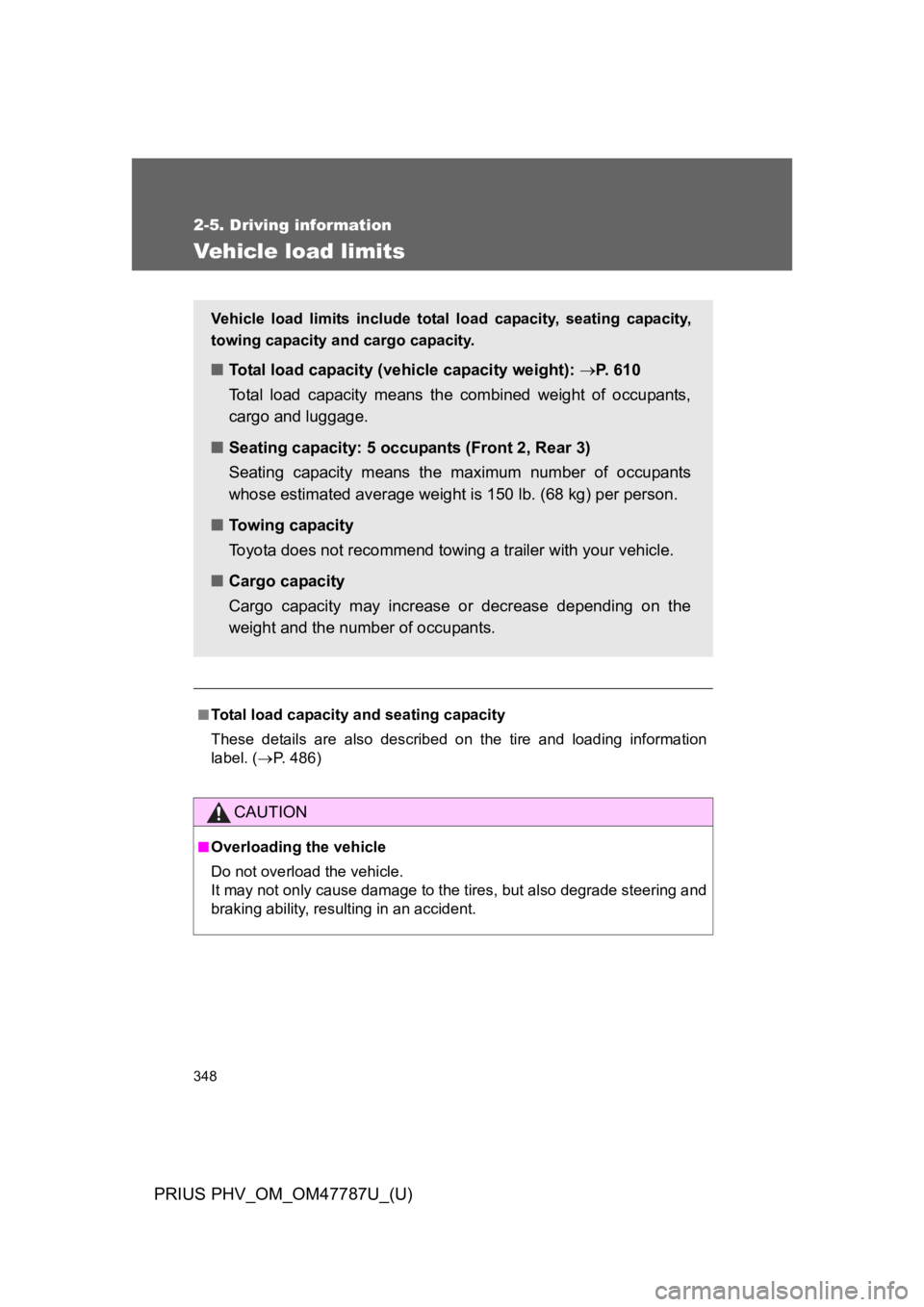
348
2-5. Driving information
PRIUS PHV_OM_OM47787U_(U)
Ve h i cl e l o a d l i m i t s
■To ta l l o a d c a pa c i t y a n d s e a t i n g c a pa c i t y
These details are also described on the tire and loading information
label. (→P. 4 8 6 )
CAUTION
■Overloading the vehicle
Do not overload the vehicle.
It may not only cause damage to the tires, but also degrade steering and
braking ability, resulting in an accident.
Ve h i c l e l oa d l i m i ts i n c l u d e t o ta l l o a d c a pa c i t y, s e a t i ng c a pa c i t y,
towing capacity and cargo capacity.
■To ta l l o a d c a pa c i t y ( v e h i c l e c a pa c i t y w e i g h t ) : →P. 6 1 0
To t a l l o a d c a p a c i t y m e a n s t h e c o m b i n e d w e i g h t o f o c c u p a n t s ,
cargo and luggage.
■Seating capacity: 5 occupants (Front 2, Rear 3)
Seating capacity means the maximum number of occupants
whose estimated average weight is 150 lb. (68 kg) per person.
■To w i n g c a pa c i t y
To y o t a d o e s n o t r e c o m m e n d t o w i n g a t r a i l e r w i t h y o u r v e h i c l e .
■Cargo capacity
Cargo capacity may increase or decrease depending on the
weight and the number of occupants.
Page 505 of 704
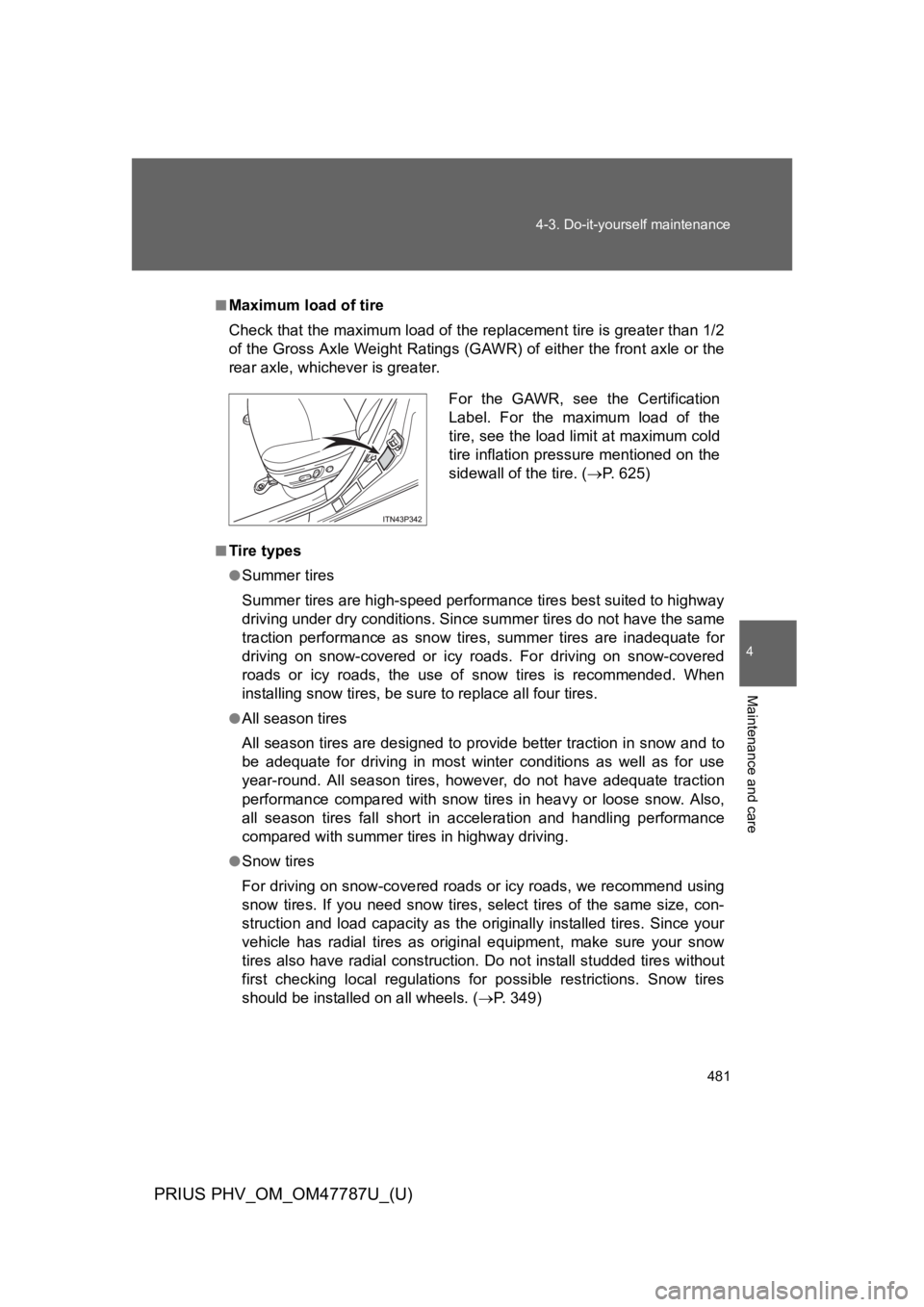
481
4-3. Do-it-yourself maintenance
PRIUS PHV_OM_OM47787U_(U)
4
Maintenance and care
■Maximum load of tire
Check that the maximum load of the replacement tire is greater than 1/2
of the Gross Axle Weight Ratings (GAWR) of either the front axle or the
rear axle, whichever is greater.
■Tire types
●Summer tires
Summer tires are high-speed performance tires best suited to highway
driving under dry conditions. Since summer tires do not have the same
traction performance as snow tires, summer tires are inadequate for
driving on snow-covered or icy roads. For driving on snow-covered
roads or icy roads, the use of snow tires is recommended. When
installing snow tires, be sure to replace all four tires.
●All season tires
All season tires are designed to provide better traction in snow and to
be adequate for driving in most winter conditions as well as for use
year-round. All season tires, however, do not have adequate traction
performance compared with snow tires in heavy or loose snow. Also,
all season tires fall short in acceleration and handling performance
compared with summer tires in highway driving.
●Snow tires
For driving on snow-covered roads or icy roads, we recommend using
snow tires. If you need snow tires, select tires of the same size, con-
struction and load capacity as the originally installed tires. Since your
vehicle has radial tires as original equipment, make sure your snow
tires also have radial construction. Do not install studded tires without
first checking local regulations for possible restrictions. Snow tires
should be installed on all wheels. (→P. 3 4 9 )
For the GAWR, see the Certification
Label. For the maximum load of the
tire, see the load limit at maximum cold
tire inflation pressure mentioned on the
sidewall of the tire. (→P. 6 2 5 )
Page 514 of 704
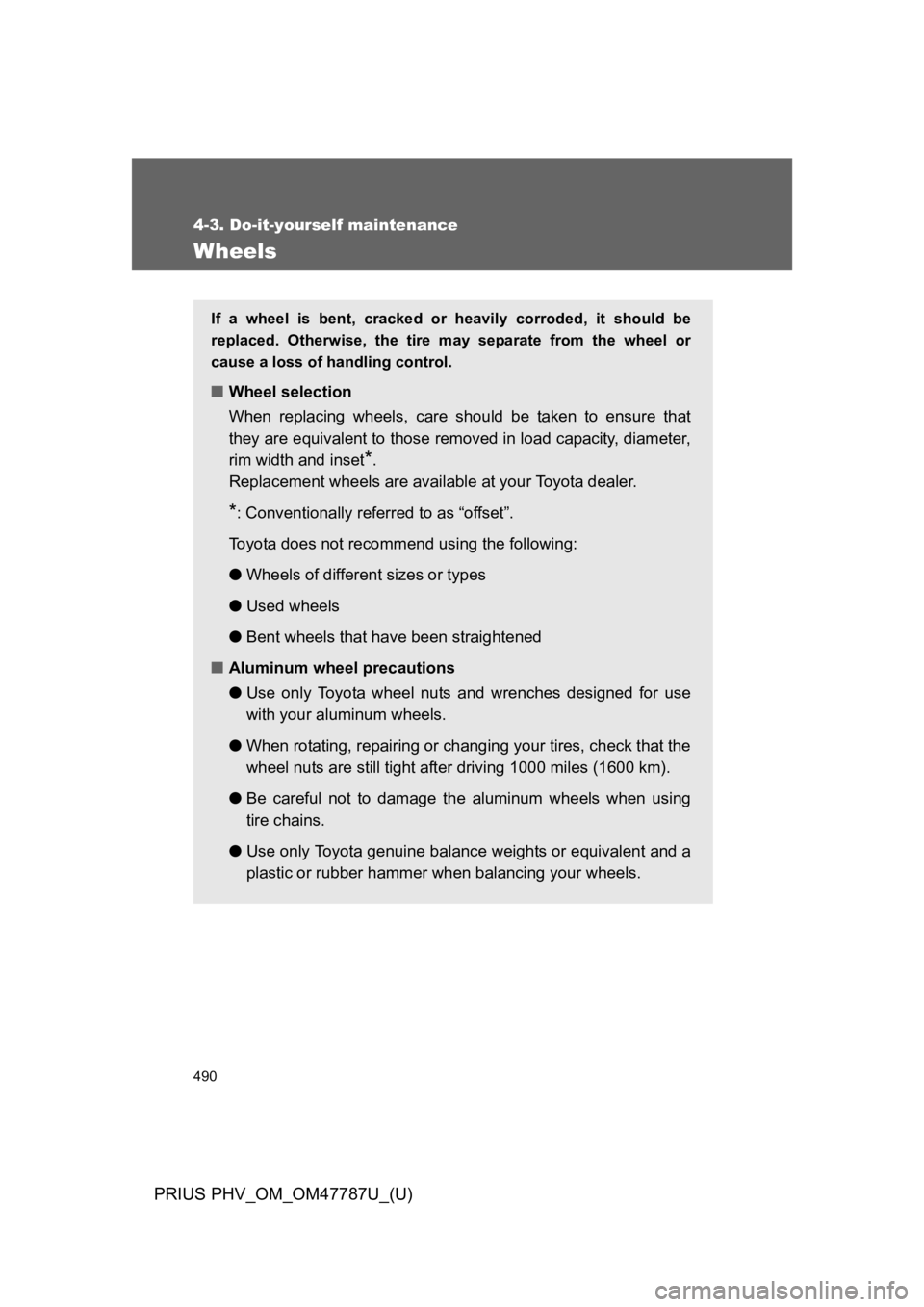
490
4-3. Do-it-yourself maintenance
PRIUS PHV_OM_OM47787U_(U)
Wheels
If a wheel is bent, cracked or heavily corroded, it should be
replaced. Otherwise, the tire may separate from the wheel or
cause a loss of handling control.
■Wheel selection
When replacing wheels, care should be taken to ensure that
they are equivalent to those removed in load capacity, diameter,
rim width and inset*.
Replacement wheels are available at your Toyota dealer.
*: Conventionally referred to as “offset”.
To y o t a d o e s n o t r e c o m m e n d u s i n g t h e f o l l o w i n g :
●Wheels of different sizes or types
●Used wheels
●Bent wheels that have been straightened
■Aluminum wheel precautions
●Use only Toyota wheel nuts and wrenches designed for use
with your aluminum wheels.
●When rotating, repairing or changing your tires, check that the
wheel nuts are still tight after driving 1000 miles (1600 km).
●Be careful not to damage the aluminum wheels when using
tire chains.
●Use only Toyota genuine balance weights or equivalent and a
plastic or rubber hammer when balancing your wheels.
Page 653 of 704

631
6-1. Specifications
6
Vehicle specifications
PRIUS PHV_OM_OM47787U_(U)
Glossary of tire terminology
Tire related termMeaning
Cold tire inflation pres-
sure
Tire pressure when the vehicle has been
parked for three hours or more, or has not
been driven more than 1 mile or 1.5 km under
that condition
Maximum inflation
pressure
The maximum cold inflated pressure to which a
tire may be inflated, shown on the sidewall of
the tire
Recommended infla-
tion pressure
Cold tire inflation pressure recommended by a
manufacturer
Accessory weight
The combined weight (in excess of those stan-
dard items which may be replaced) of auto-
matic transmission, power steering, power
brakes, power windows, power seats, radio
and heater, to the extent that these items are
available as factory-installed equipment
(whether installed or not)
Curb weight
The weight of a motor vehicle with standard
equipment, including the maximum capacity of
fuel, oil and coolant, and if so equipped, air
conditioning and additional weight optional
engine
Maximum loaded vehi-
cle weight
The sum of:
(a) Curb weight
(b) Accessory weight
(c) Vehicle capacity weight
(d) Production options weight
Page 654 of 704

632
6-1. Specifications
PRIUS PHV_OM_OM47787U_(U)
Tire related termMeaning
Normal occupant
weight
150 lb. (68 kg) times the number of occupants
specified in the second column of Table 1* that
follows
Occupant distributionDistribution of occupants in a vehicle as speci-
fied in the third column of Table 1* below
Production options
weight
The combined weight of installed regular pro-
duction options weighing over 5 lb. (2.3 kg) in
excess of the standard items which they
replace, not previously considered in curb
weight or accessory weight, including heavy
duty brakes, ride levelers, roof rack, heavy duty
12-volt battery, and special trim
RimA metal support for a tire or a tire and tube
assembly upon which the tire beads are seated
Rim diameter
(Wheel diameter)Nominal diameter of the bead seat
Rim size designation Rim diameter and width
Rim type designationThe industry manufacturer’s designation for a
rim by style or code
Rim width Nominal distance between rim flanges
Ve h i c l e c a pa c i t y
weight (Total load
capacity)
The rated cargo and luggage load plus 150 lb.
(68 kg) times the vehicle’s designated seating
capacity